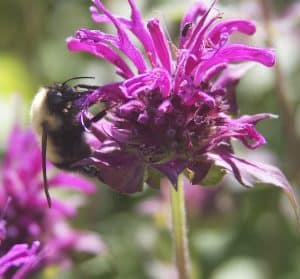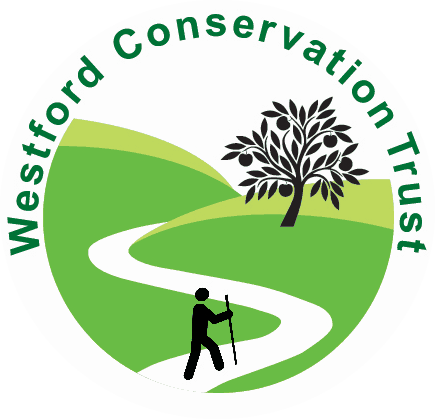
Bees are keystone species in the web of life. The presence of bees in our yards and open spaces is essential to the pollination and flourishing of our plants, and thus to our own lives. Dick Callahan, legislative director for the Massachusetts Beekeepers Association states that around the world, 40-50% of insect species are declining. In Massachusetts, we had a 47% drop in successful beehive colonies in the past year. When insect numbers drop, so do bird populations, which rely on insects for food. So why are we killing them?
Hannah Uebele, associate producer for Boston Public Radio, recently wrote about the effect pesticides are having on our native insects, especially on bees.
Gardeners may spray their yards and gardens with pesticides to rid themselves of unwanted insects. But all insects are affected by pesticides. The most widely used pesticides are neonicotinoids, or neonics for short. After years of lobbying by beekeepers and others, Massachusetts has voted to categorize neonics as “restricted-use products”. Under new rules, homeowners will no longer be able to purchase neonics made for “turf/lawn, tree/shrub, ornamental and vegetable and flower gardens.” The Massachusetts Pesticide Board Subcommittee determined that these uses may pose unreasonable adverse effects to the environment as well as to pollinators, when taking into account the economic, social and environmental costs and benefits of their use in the commonwealth”. Anita Deeley, founder of Beverly Bees, explains, “Neonics are systemic pesticides, meaning that they are absorbed by the plant and last in the environment much longer than other types of pesticides….They get into every cell of the plant. They get put into the soil that the plant grows in. They go into our water supply. And they get into the pollen and the nectar that the bees eat….That’s how the bees get poisoned.”
Neonics will be removed from retail shelves by July, 2022. Licensed pesticide applicators will still be able to use neonics, but Drew Toher, of Beyond Pesticides, is encouraging farmers and landscaping companies to use organic products. Canada and the European Union have outlawed outdoor use of neonics and have had no disruption to their agriculture. For a list of organic herbicide, pesticide, fertilizer and repellent alternatives explore the website at Beyondpesticides.com.
Perhaps this year, you might want to investigate organic alternatives to neonics. We can all do our part to save the bees!
Many thanks to all flora and fauna reporters for the month of April. Please send reports by May 26 to appear in next month’s column. You can call me at 692-3907, e-mail me at mariancharman@gmail.com, or write to me at 7A Old Colony Drive.
——————
Late March Reports:
Marian/Bill Harman, Old Colony Drive. March 26–76 degrees!
March 29, a walk to the beaver dam: pair of ring-necked ducks on Keyes Pond, three wood ducks on Snake Meadow Brook. Little pines coming up in the blown-down area of woods, great blue heron in swamp. March 30, 60 degrees, immature bald eagle landed in a tree by the pond.
April Reports:
Marian/Bill Harman, Old Colony Drive. April 2, 30-40 degrees. Immature bald eagle on the pond tree again, red maples blooming, fifty or more grackles and red-wings. A walk on the electric line by old highway garage: three wood ducks, mallard, Canada geese, cardinal, titmice, chickadees. A raven chased a hawk, then landed on the salt shed roof, calling loudly. Peepers and wood frogs calling from the nearby vernal pool, skunk cabbage leaves emerging. April 10, 70-80 degrees! A walk to the beaver dam, quiet palm warbler in the swamp, also an evening grosbeak (both on migration probably). Several phoebes heard, grackles, red-wings, Canada goose, titmice, white-breasted nuthatch, fish crow. April 15, I hear chipping sparrows everywhere. April 16, 32 degrees and snowing (about two inches accumulated. At feeder: about 40 red-wings and grackles, one blue jay, two pairs of cardinals, two robins, one turkey, two white-throated sparrows, one song sparrow, two doves, one red-bellied woodpecker, one chickadee. April 22, snow showers. April 23, sunny and very windy, 50’s. A walk to the beaver dam: lots of creaking and popping of trees–a bit unsettling. Saw two warblers, perhaps Nashville and pine warblers. Great blue heron rose majestically out of Snake Meadow Brook reeds. About 20 tree swallows flying over Keyes Pond, catching insects. Lots of blooming blueberry bushes, both high bush and low bush, loving the sunny bare ground where our huge blow-downs occurred last year.
Rosemarie Koester, Providence Rd. April 5, bear here a few days ago, took down and wrecked feeder, the one night we forgot to bring it in, but we were able to repair it. A male turkey attacked our car [definitely breeding season for turkeys-MH] April 24, another hummingbird reported from neighbor on Leland Rd. I found pieces of fur under our bird feeder, suspect resident hawk that lives by the marsh, caught a bunny. Hear and see tons of red-winged blackbirds. April wildlife report: Juncos last seen on April 5, one pair of robins, goldfinches, house finches, purple finches, two pairs of cardinals, two pairs blue jays, male and female red-winged blackbirds, grackles, chickadees, tufted titmouse, nuthatches, downy woodpeckers, red-bellied woodpeckers, hawk circles over, very vocal–a mournful cry. Pair of ducks on Stony Brook road, geese flying overhead, skunk cabbage near brooks, partridgeberry, princess pine.
Bob Oliphant, my friend on Concord Road, recently had his pond restocked with fish. “It didn’t take the bald eagles long to find that out. He got a nice video of the eagle flying over the pond.”
Nancy Eberiel, Depot St. April 7. Our bluebird returns periodically. An eagle has visited the yard twice, circling over today. Tree swallows swarming around Stony Brook. Goldfinch at feeder.
Diane Duane, Howard Rd. April 12, several bluebirds this winter and spring. They liked the suet and mealworms we put out. Now, an influx of red-winged blackbirds and grackles, who also enjoy the mealworms and suet along with squirrels. Bluebirds have moved on so will discontinue the dried worms. April 25, Eastern towhee, brightly colored male, eating and scratching under the feeder today–a first!
Marian Harman is a member of the Westford Conservation Trust, a non-profit conservation organization, whose mission is the protection of Westford’s open spaces and trails. The Trust welcomes new members and volunteers. Check out our website at westfordconservationtrust.org or visit us on Facebook.
